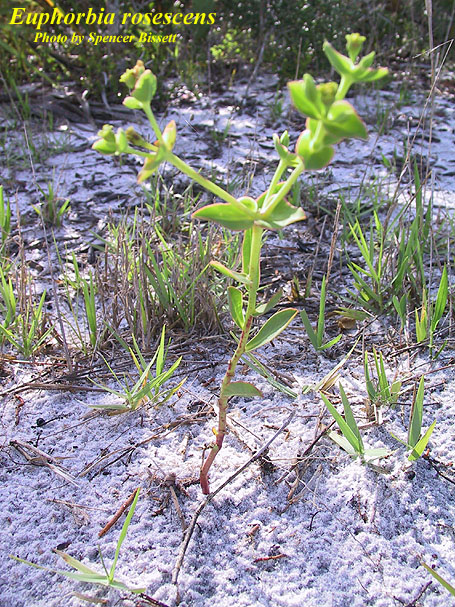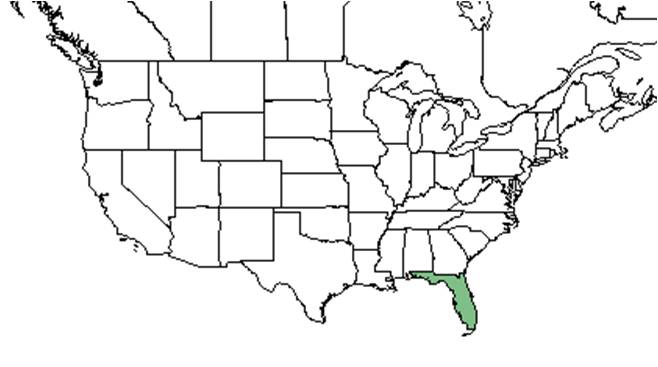Euphorbia rosescens
| Euphorbia rosescens | |
|---|---|

| |
| Photo by Spencer Bissett, Atlas of Florida Vascular Plants | |
| Scientific classification | |
| Kingdom: | Plantae |
| Division: | Magnoliophyta - Flowering plants |
| Class: | Magnoliopsida - Dicotyledons |
| Order: | Euphorbiales |
| Family: | Euphorbiaceae |
| Genus: | Euphorbia |
| Species: | E. rosescens |
| Binomial name | |
| Euphorbia rosescens E.L.Bridges & Orzell | |

| |
| Natural range of Euphorbia rosescens from USDA NRCS Plants Database. | |
Common name: Scrub spurge
Contents
Taxonomic notes
Distinguishable from Euphorbia floridana by broader stem leaves that are not reflexed and do not abruptly contrast with ovate bracteal leaves on the inflorescence.[1]
Description
Euphorbia rosescens is a slightly succently, blue-green herb[1] and is often a single stem and can be seen growing in clusters.[2] The leaves are elliptic to oblanceolate or obovate-spatulate.[1] Flowers are unisexual and occur in cyathia that develop acropetally and are arranged on a compound inflorescense.[2]
Distribution
Distribution is limited to a 50 kilometer range on the well drained sands of the Lake Wales Ridge.[3] There are fewer than 20 known sites.[4]
Ecology
Habitat
E. rosescens has been found in the xeric sand entisols of the Lake Wales Ridge, sand pine scrub, scrubby flatwoods, Florida rosemary scrub, and oak scrub. It is also found in disturbed areas including sandy roads, firebreaks, disturbed scrub habitat, improved pasture, and vacant lots of cleared former sand pine scrub.[5][6]
Phenology
The flowers of E. rosescens are unisexual and occur within cyathia that develop acropetally, arranged on a compound inflorescense.[2]
Pollination and use by animals
Euphorbia rosescens is visited by thread-waisted wasps from the Sphecidae family (Bembecinus nanus floridanus, Tachysphex apicalis, T. similis and Tachytes mergus) and wasps from the Vespidae family (Leptochilus krombeini)[7]
Conservation, cultivation, and restoration
Range is limited to Highlands county on the Lake Wales Ridge, and there are fewer than 20 known sites. The ridge is quickly being converted into agricultural lands and urban development. The existing scrubs are becoming overgrown with fire suppression.[4] Archbold currently monitors this species.[8]
G1-critically imperiled.[4]
Cultural use
Members of this genus can be used as a laxative in small amounts, but an overdose can cause severe poisoning.[9]
Photo Gallery
References and notes
- ↑ 1.0 1.1 1.2 [NatureServe]Accessed: December 11, 2015
- ↑ 2.0 2.1 2.2 [Archbold Biological Station] Accessed: December 11, 2015
- ↑ [[1]]Accessed: December 11, 2015
- ↑ 4.0 4.1 4.2 [Encyclopedia of Life]Accessed: December 11, 2015
- ↑ Archbold Biological Station herbarium accessed using Southeastern Regional Network of Expertise and Collections (SERNEC) data portal. URL: http://sernecportal.org/portal/collections/index.php Last accessed: May 2021. Collectors: L. Calabrese. States and Counties: Florida: Highlands.
- ↑ Atlas of Florida Plants Institute for Systematic Botany. URL:https://florida.plantatlas.usf.edu/Default.aspx Last accessed: May 2021. Collectors: S. L. Orzell. States and Counties: Florida: Highlands.
- ↑ Deyrup, M.A. and N.D. 2015. Database of observations of Hymenoptera visitations to flowers of plants on Archbold Biological Station, Florida, USA.
- ↑ [[2]] Accessed: December 11, 2015
- ↑ Mueschner, W.C. 1957. Poisonous Plants of the United States. The Macmillan Company, New York.